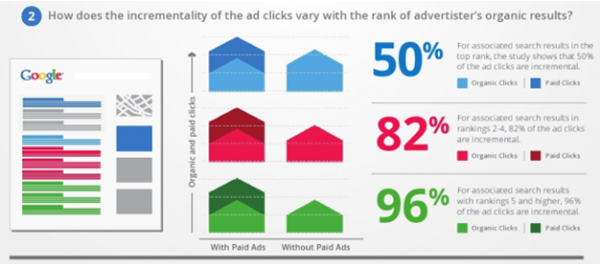Most marketers would agree that to be competitive, we do not operate in an either/or environment.
It’s not a choice between either SEO or social, or SEO and PPC. It’s a requirement that we understand how these channels work together to impact one another, and a website’s ability to stay afloat in the growing search results.
The surge in content marketing, including the focus on organic content and social media as a pair has perhaps taken some focus away from the synergy that SEO and PPC have together.
The numbers don’t lie. Brands are still heavily investing in PPC – and many are doing so rather than adopting strategies that would employ organic and paid search together. In fact, PPC’s ROI is becoming clearer with data from Kenshoo that shows revenue is growing faster than PPC spend YoY in the Americas.

And, research coming from The Search Agency shows spend was up on paid search YoY in Q1 2014, with total spend increased by 35 percent. Specifically, Bing Ads saw a 60-percent growth in spend, which was more than double that of Google AdWord’s 29-percent growth.
 
Many brands understand the impact the two channels have together, too, with the majority (80 percent) indicating paid search complemented their organic search marketing in the SEMPO State of Search Marketing Report 2013.
 
Still, some brands haven’t fully explored how the two can work together to inform strategy. One team may focus on the paid side, the other team, on the organic – and those two teams may have little to no communication.
So let’s explore why SEO and PPC should be a partnership, and how you can leverage them together to inform strategy.
Impact: How SEO PPC Work In Tandem For Clicks Conversions
1. Clicks
2012 data from Google demonstrates the delicate dance between organic rank and PPC-driven traffic. The Google study found that PPC was able to do some heavy lifting for websites dependent upon how strong the organic search results were. As reported by Search Engine Land:
The study found that 82% of ad clicks are incremental when the associated organic result is ranked between 2 and 4, and 96% of clicks are incremental when the brand’s organic result was 5 or below.
 
In other words, those visits would not have occurred without the ad campaigns, Google says.
In a September 2013 report by Kenshoo on the synergy of SEO and PPC (specifically studying the performance of Hewlett-Packard’s marketing), the data supports this concept of organic rank and PPC campaigns, showing PPC traffic specifically rising and falling in conjunction with organic search results:
 
2. Conversions
It’s not hard to see the impact that SEO and PPC together can have on conversions. All you need to do is log into Google Analytics and have a look at the multi-channel funnels report.
Marketers have used the data in these reports to explain the importance of a holistic digital marketing plan since the data first became available. The multi-channel funnels report is just one way to create a quantifiable argument that success is not confined to one channel.
 
Taking this analysis of ROI a step further, using the multi-channel funnels assisted conversions report, we can begin to understand which channels contribute to conversions overall and how:

Now we can explore the next level of analysis by attribution modeling, so we can grow resources for channels based on their overall contribution. For more on modeling, check out this post on multi-channel attribution by Web analytics guru Avinash Kaushik.
Inform: How SEO PPC Data Enlighten Strategy, Together
Both SEO and PPC used to have free-flowing data about keywords. This made it easier to see which keywords drove conversions in PPC or SEO; then we could use that data to inform optimization of one channel or the other.
And while we’re severely limited today in terms of keyword data in Web analytics specifically, this concept can still apply if we shift our perspective a bit.
Though Google recently announced it would stop passing search query data on paid search clicks, this is limited to the PPC data we see in Google Analytics. This means brands still have access to keyword data at the AdWords dashboard level, and always will.
But, given the limited paid search keyword data in GA, this is where SEO data can inform PPC strategy. Many tools companies have stepped up to the challenge. We at BrightEdge have developed a Secure Search solution key integration with Google Webmaster Tools that has helped customers adapt to market change.

We know that if we have Web analytics data that show traffic and conversions, we can map that to pages, indefinitely. The shift in focus from keywords to pages, then, becomes even more important in the paradigm of keyword “(not provided)†data.
If you’re lucky enough to have some organic keyword data still, use it. If you have high-converting keywords showing on the organic side of search, by all means, go and bid on those in PPC to test your theories out.
But in absence of this keyword data, you may still have high-converting Web pages. And this is the type of data a lot of businesses are starting with if they’ve only focused on organic and not paid search.
With that data in hand, one way businesses can inform PPC strategy is to have a better picture of which pages to drive PPC traffic to (assuming there is a tie-breaker for relevancy to the ad).
And there are other ways to slice and dice top landing pages by channel to give a big picture view. In another useful post from Kaushik, he outlines how to cross-compare SEO and PPC on a landing page-basis by applying his custom landing pages report (click link to download the GA custom report), and then applying your organic search segment and paid search segment to create a report that looks something like this:

What this report can provide is the top landing pages receiving traffic from organic search and paid search, and the user-orientated metrics (bounce rate, time on page, page value and so on).
Further examining the top-converting landing pages in organic can lend insight into how PPC landing pages might be improved. What are the key elements on that page? What’s the topic about? Is there anything that can gleaned from those Web pages to boost conversions on PPC-specific landing pages?
We also know SEO bleeds over to PPC in other ways. Consider the AdWords Quality Score, which rates how relevant a page is for the ad that’s pointing to it. That said, basic on-page optimization tactics help ensure this type of relevancy.
Â
Lastly, you can use your organic rank to determine and control your PPC budget. If you’re in Position 1 organically, you may decide you don’t need to secure the No. 1 position in PPC for a keyword. As we learned from the data presented earlier, the relationship between organic rank and PPC traffic matters.
Integrate, Don’t Separate
By intelligently integrating your paid and organic search activity, synergies provide greater results in SERP domination. After all, they’re all part of the same real estate that your brand needs to invest in. Content is the glue that binds your SEO and PPC strategies.
What’s important here is not only recognizing how the two channels impact one another, but how you can inform your strategy in either SEO or PPC based on data from the other channel.
Ultimately, we know that no matter how brilliant your site is, if it’s not ranking effectively through paid or organic results, it’s likely to go unnoticed.
 (Stock image via Shutterstock.com. Used under license.)
Opinions expressed in the article are those of the guest author and not necessarily Search Engine Land.
Related Topics: All Things SEO Column | Channel: SEO | Google: AdWords | Google: Analytics | Search Ads
Article source: http://searchengineland.com/seo-ppc-serp-real-estate-content-glue-roi-194073
